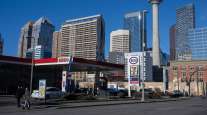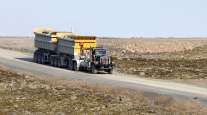Fleets Seek More Uniformity in Inspections of Shipments Crossing U.S.-Canada Border
By Eric Miller, Staff Reporter
This story appears in the March 14 print edition of Transport Topics.
Even with the proper security credentials, it’s a bit of a crapshoot every time one of Kevin Hogan’s company trucks leaves a terminal in Ontario for a border crossing with a load of freight bound for the United States.
The truck may sail through the gate in minutes, or it may be held up for hours for an inspection or X-ray by a suspicious U.S. border patrol agent, said Hogan, operations manager for Premium Transportation Inc., Centralia, Ontario.
“I wish there would be some uniformity. Sometimes, you get the feeling that they don’t want our goods over there, with the ruckus that the drivers go through to get across the border,” Hogan added.
Things don’t seem much better on the other side of the border, said Brad Wood, customs compliance manager for Celadon Trucking Services, Indianapolis. The company is a unit of Celadon Group, which ranks No. 42 on the Transport Topics Top 100 list of for-hire carriers in the United States and Canada.
“We’ve jumped though all the hoops that they’ve asked us to jump through to get our trucks across the border more efficiently,” Wood said. “But [efficiency] just doesn’t seem to be happening.”
But now that could change. There is renewed optimism that a formal agreement at the very top levels of government in both countries will find some solutions to the congestion mess at many U.S.-Canada border crossings and at the same time improve security coordination among law enforcement agencies.
The agreement that President Obama and Canadian Prime Minister Stephen Harper signed last month calls for the formation of a joint border council to review over the next two years everything from incompatible electronic transponders to paper cargo manifests that put a drag on crossing border checkpoints.
Until the agreement kicks into high gear, however, the problems remain.
“The biggest thing is discrepancies between the customs officers,” Premium Transportation’s Hogan told Transport Topics. “It depends on who you get when you come up to the booth. Even with the same load, if you get X customs agent, you drive right on through, and if you get Y agent, you go for an X-ray.”
An X-ray or inspection can mean a delay of several hours, just enough so that the truck driver can’t return home the same night after making a delivery, Hogan said.
Wood said that Celadon has virtually every possible security credential a carrier can have.
“Celadon is a FAST, CSA, PIP and C-TPAT-approved carrier,” Wood told TT. “We have all these credentials, and we’re supposed to be a trusted carrier. But yet, we’re still seeing several delays at the border in and out of Canada subject to random inspections.”
Of course, these border crossing delays are really nothing new to motor carriers that send their trucks across busy ports at the U.S.-Canadian border. The question is: Will things really change?
Trucking industry representatives in both countries welcomed the announcement about the new agreement. The hope now is that the bureaucrats running the joint project will bring to the table representatives of trade groups and motor carriers whose trucks encounter border challenges on a daily basis.
The concern, however, is that the so-called U.S.-Canadian Regulatory Cooperation Council, composed of agencies from both countries that deal with security, trade and infrastructure at the border, will be top-heavy with government bureaucrats who see the problems from 30,000 feet.
David Bradley, president and CEO of the Canadian Trucking Alliance, said he has heard such promises of streamlining the border in the past, only to end up disappointed with the results.
“It will be essential for the governments to truly consult with the organizations whose members and businesses are living the border problems every day,” Bradley said in a statement.
Bill Graves, president of American Trucking Associations, called the agreement “a positive first step to increasing the competitiveness of business on both sides of the border.”
But Margaret Irwin, director of customs, immigration, and cross-border operations for ATA, said that the new problems the council will discuss likely will be the same ones officials have been “talking about for years.”
“We’re talking about reverse inspections, harmonizing regulations requirements at the border, and harmonizing the IT [information technology] part of it so that the manifests are equal,” Irwin told TT.
She said some of the same issues between Canada, Mexico and the United States were on the agenda during 2005 working group meetings of the Security and Prosperity Partnership of North America.
It was during those 2005 meetings that the promising idea of “reverse inspections” came up, but an attempt to test the system at a crossing in Buffalo was rejected by then-Homeland Security Secretary Michael Chertoff, Irwin said.
Under a reverse-inspection system, U.S. and Canadian customs officials would set up stations on opposite sides of the border.
“It would take congestion off the bridge, or away from the bridge,” Irwin said.
Jennifer Fox, CTA’s vice president for customs issues, said that since 9/11, security “has been the name of the game” at the border.
“It’s been trumping trade,” Fox said. “Layer after layer of security initiatives has caused industry to have to adopt, invest and find workarounds that have resulted in slowdowns and administrative burden and cost.”
Ironically, such criticisms are being made only weeks after a congressional report concluded that the terrorist threat along the Canadian-U.S. border is high because of limited law enforcement and a lack of interagency coordination.
U.S. Customs and Border Patrol officials, however, say they do their best to balance security and the flow of goods.
“While security is our core mission, CBP also has important trade responsibilities,” Alan Bersin, commissioner of U.S. Customs and Border Protection, Department of Homeland Security, told a Senate committee last year.
“Our security and trade facilitation missions are mutually supportive. By utilizing risk-based strategies and applying a multilayered approach, we can focus our time and resources on the small percentage of goods that are high-risk or about which we know the least — which, in turn, allows us to expedite trade that is low-risk or about which we already know a great deal,” Bersin said.
To fully meet the agency’s responsibilities, Bersin said, it must identify and stop threats before they arrive at American ports. That requires that CBP “secure the flow of cargo at each stage of the supply chain — at the point of origin, while in transit, and when it arrives in the United States,” Bersin said.
But Fox said that CTA would like to see changes that would better utilize border crossing lanes designed for carriers that participate in CBP’s Free and Secure Trade program, or FAST.
The FAST program allows for expedited processing for commercial carriers that have completed background checks and fulfilled certain eligibility requirements.
“Right now, use of the FAST lanes is so contingent on whether or not a carrier’s customers have participated in those programs,” Fox said. “The benefit is almost lost completely for just a carrier.”
Fox added: “The companies that have made the investments have done what they needed to do for years on end now to prove that they’re secure. Now, what is the government prepared to do to help facilitate trade?”
But Bersin testified that CBP needs the trade community to assume its fair share of the security burden, to exercise reasonable care in customs matters, provide information to better understand the parties to a transaction, and to invest in the resources necessary to keep up with current requirements.
“We weigh the cumulative costs of our decisions on business and, when possible, provide for simplified commercial processing,” Bersin said. “CBP and the trade community must be partners, leveraging both parties’ expertise.”
Jeff Bryan, president of Jeff Bryan Transport Ltd., Burford, Ontario, said trusted traveler programs are a great idea, but that he doesn’t think “they’re embraced by all the customs officials.”
Bryan said his biggest concern with the post 9/11 security regulations involves an inequity related to “in transit” trips that carriers make though the United States to save mileage and time when they make deliveries to receivers on Canada’s West Coast.
Bryan said in past years his company would make trips to Vancouver, British Columbia, by crossing into Port Huron, Mich., and cut a path across the United States below Chicago.
“But today the paperwork required to put an in-transit bond through the United States is so burdensome to the shippers that they’re not willing to do it,” Bryan said. “Essentially you have to create a U.S. Customs invoice for a shipment that’s not destined for the U.S.”
By contrast, a U.S. carrier traveling from Buffalo to Detroit travels though Canada with little hassle, Bryan said.
“We all understand that we’re trying to protect the security of the American people and the Canadian people,” Bryan said. “But we have to be able to get across the border with our commerce.”
Greg Palmer, owner of Trans-Freight-McNamara, Ayr, Ontario, also said his company used to do in-transits from Toronto to Vancouver. Going through the United States is 200 miles shorter and a carrier doesn’t have to brave bad Canadian highways in winter, he said.
The in-transit route also would allow the Canadian carrier to dump a small load in Michigan on the way.
“There’s some inequity there, and it’s not an equal playing field from a competition perspective,” Palmer said.
Meanwhile, the delicate balance between security and the flow of commerce at the border will continue to be a hot button for the industry.
Only time will tell if the new commission can tamp the widespread criticism.
“I think we’re hoping that they go deeper than the superficial stuff,” ATA’s Irwin said. “There’s been a chronic habit to pick off the easy stuff — put a couple more booths up or more officers on.




